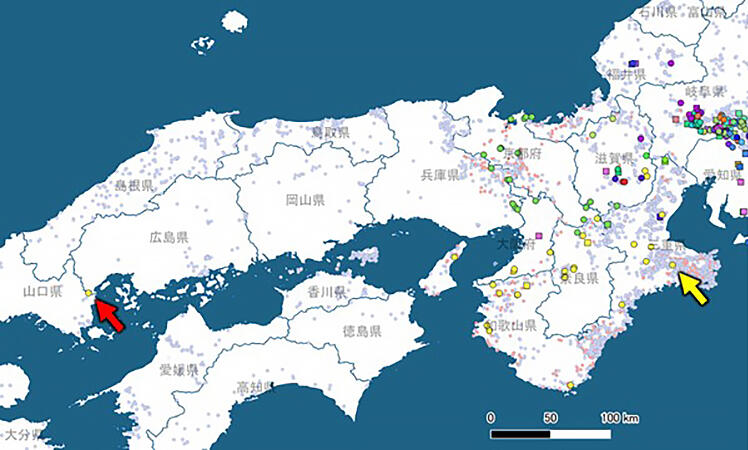A research group led by Takehisa Yamamoto, leader of the Division of Transboundary Animal Disease Research at the National Institute of Animal Health, National Agriculture and Food Research Organization (NARO), has revealed on May 16 that a virus originating from wild boars infected with swine fever confirmed in Yamaguchi Prefecture in March is most closely related to a boar-derived virus that was confirmed in the eastern Kii Peninsula, about 500 km away in May last year. It is unlikely that long-distance transmission occurred solely through boar migration or boar-to-boar contact. Instead, it may have been introduced to remote areas through some type of human activity. The spread of the virus can also occur when it gets on shoes or clothing and is carried from one place to another. NARO is urging people who enter wild boar habitats for leisure, hunting or forest work to wash their shoes to prevent the spread of infection.

Provided by NARO
Swine fever is a disease of pigs and wild boars spread by infection of the swine fever virus, which is highly infectious and has a high mortality rate. The virus does not affect humans and no cure exists. Because of this, infected animals are killed, and livestock are vaccinated in infected areas, in accordance with the Act on Domestic Animal Infectious Diseases Control when an outbreak occurs.
In Japan, the first outbreak of swine fever in 26 years was confirmed at a pig farm in September 2018 and was later confirmed in wild boars near the farm where the outbreak occurred. Currently, positive wild boars and pigs have been confirmed mainly in the Kansai region and in the Kanto and Tohoku regions. However, infections are also spreading. Previous analysis has shown that the virus that caused the first outbreak in 26 years is not a strain that was prevalent in Japan but is closer to a strain that has been prevalent in Asia in recent years and is likely to have come from overseas.
On March 13, swine fever was first confirmed in Yamaguchi Prefecture from a wild boar that had died. Prior to that time, the westernmost location of the outbreak was Hyogo Prefecture, and Yamaguchi, Shimane, and Hiroshima prefectures were not included in the vaccination area. In order to ascertain the infection status in wild boars, the Ministry of Agriculture, Forestry and Fisheries (MAFF) has been conducting swine fever surveillance on dead wild boars found in all prefectures in Japan and on boars captured by hunting or other means.
In this study, the research group isolated swine fever virus from samples of swine fever-infected boars and pigs provided by prefectures at the request of the prefectural governments or by the MAFF and conducted a genetic analysis. Specifically, they analyzed 330 virus strains derived from wild boars, including those from Yamaguchi Prefecture, and 84 virus strains derived from outbreak farms for almost the entire length of the gene. Comparisons were made using base mutations found in common between two or more viruses as an indicator.
Their results showed that the gene sequences of viruses prevalent among wild boars in the Kansai region differed between the southern and northern parts of the region. They also found that the boar-derived virus from Yamaguchi Prefecture was closer to the virus from the southern Kansai area, which is more remote than the northern area, with the closest match coming from wild boars caught in Mie Prefecture in 2021.
Although the conclusion is not definitive, due to the comparison being based only on the genetic information of the swine fever virus that is currently available, it is highly likely that the infection in Yamaguchi Prefecture occurred through human activity because the normal range of movement of wild boars is 1-2 km, and long-distance movement makes transmission difficult between boars. The need for further vigilance has become clear.
"In this study, we investigated the relationship between viruses based on genetic information, and genetic information is also related to the strength of virulence and the effectiveness of vaccines," says Dr. Yamamoto. "Moving forward, we would like to use this information from multiple angles to compare genetic information of domestic and foreign viruses and study changes in them."
This article has been translated by JST with permission from The Science News Ltd.(https://sci-news.co.jp/). Unauthorized reproduction of the article and photographs is prohibited.




